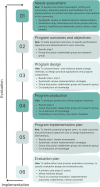The development of BE-EMPOWERed: Belgian program Enhancing the uptake and Effectiveness of a Multifactorial falls Prevention intervention in Older community-dWElling peRsons
- PMID: 40474058
- PMCID: PMC12142946
- DOI: 10.1186/s12877-025-05879-9
The development of BE-EMPOWERed: Belgian program Enhancing the uptake and Effectiveness of a Multifactorial falls Prevention intervention in Older community-dWElling peRsons
Abstract
Background: Falls among people aged 65 years and older represent a global health challenge, with substantial morbidity, mortality and economic costs. Despite strong evidence supporting the efficacy of multifactorial falls prevention interventions, their implementation in community settings remains inconsistent. There is a need to systematically develop and proactively tailor multifactorial falls prevention interventions and implementation strategies to the context. This study aims to describe the systematic development of the BE-EMPOWERed program, a comprehensive falls prevention initiative, and its corresponding implementation strategies to enhance the uptake and effectiveness of a multifactorial falls prevention interventions in community-dwelling older people.
Methods: The BE-EMPOWERed program was developed using Intervention Mapping (IM) and Implementation Mapping guided by the Medical Research Council (MRC) framework. The development process involved co-production with key stakeholders, including older people, healthcare professionals, and local policymakers, ensuring the program's relevance and feasibility in real-world settings. The program components were pretested, refined, and evaluated through iterative cycles within primary care areas, incorporating continuous feedback from participants and implementation facilitators to address the complexities of the context and real-world implementation.
Results: The BE-EMPOWERed program includes a group-based intervention for older people and workshops for healthcare professionals. A detailed implementation plan was created and implementation facilitators were trained to support the adoption of multifactorial falls prevention interventions across primary care areas in Flanders. Key implementation strategies for older people included tailored interventions, personal risk assessments, active learning, participation and opportunities for social comparison. For healthcare professionals, the strategies focused on raising awareness, guided practice and coalition-building. Additionally, active learning, guided practice, stakeholder engagement, community development and agenda setting were pivotal in training implementation facilitators and executing the implementation plan.
Conclusions: The successful implementation of multifactorial falls prevention interventions in community settings requires addressing multiple contextual levels, from individual to organizational and policy-related factors. This study provides a comprehensive guide for the systematic development and implementation of complex interventions, offering practical insights for future initiatives aimed at improving community-based health outcomes, enhancing program sustainability, and facilitating the broader application of falls prevention interventions.
Keywords: Aged; Community setting; Falls prevention; Implementation.
© 2025. The Author(s).
Conflict of interest statement
Declarations. Ethics approval and consent to participate: Research have been performed in accordance with the Declaration of Helsinki. Ethical approval was obtained from the Social and Societal Ethics Committee of Leuven University Hospitals, on 26 January 2023 [G-2022-5783-R3(AMD)]. All participants provided written informed consent. All methods were performed in accordance with the relevant guidelines and regulations. Consent for publication: No personal data were included in this manuscript. Competing interests: The authors declare no competing interests.
Figures






Similar articles
-
Context makes a difference: a qualitative study exploring how to implement a multifactorial falls prevention intervention in the community.BMC Public Health. 2025 Feb 5;25(1):485. doi: 10.1186/s12889-025-21561-6. BMC Public Health. 2025. PMID: 39910393 Free PMC article.
-
Determinants influencing the implementation of multifactorial falls risk assessment and multidomain interventions in community- dwelling older people: a systematic review.Age Ageing. 2024 Jul 2;53(7):afae123. doi: 10.1093/ageing/afae123. Age Ageing. 2024. PMID: 38952187
-
Effectiveness of multifactorial interventions in preventing falls among older adults in the community: A systematic review and meta-analysis.Int J Nurs Stud. 2020 Jun;106:103564. doi: 10.1016/j.ijnurstu.2020.103564. Epub 2020 Mar 7. Int J Nurs Stud. 2020. PMID: 32272282
-
A co-designed conceptual model for implementing falls prevention programmes for community-dwelling older adults in Singapore: a systems thinking approach.Age Ageing. 2025 Feb 2;54(2):afaf021. doi: 10.1093/ageing/afaf021. Age Ageing. 2025. PMID: 39976285 Free PMC article.
-
Perceptions of Facilitators and Barriers to Implementation of Falls Prevention Programs in Primary Health Care Settings in China.JAMA Netw Open. 2022 Aug 1;5(8):e2228960. doi: 10.1001/jamanetworkopen.2022.28960. JAMA Netw Open. 2022. PMID: 36018587 Free PMC article.
References
-
- World Health Organisation. Falls 2024 [26 July 2024]. Available from: https://www.who.int/news-room/fact-sheets/detail/falls
-
- Kannus P, Sievänen H, Palvanen M, Järvinen T, Parkkari J. Prevention of falls and consequent injuries in elderly people. Lancet. 2005;366(9500):1885–93. - PubMed
-
- Close JCT, Lord SR. Fall prevention in older people: past, present and future. Age Ageing. 2022;51(6). - PubMed
MeSH terms
LinkOut - more resources
Full Text Sources
Medical

